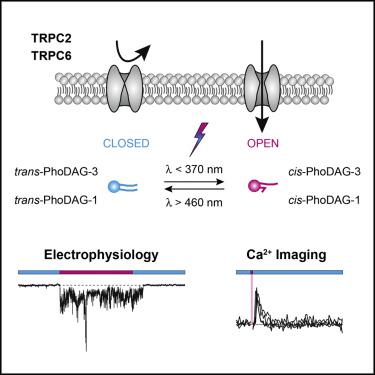当前位置:
X-MOL 学术
›
Cell Chem. Bio.
›
论文详情
Our official English website, www.x-mol.net, welcomes your
feedback! (Note: you will need to create a separate account there.)
PhoDAGs Enable Optical Control of Diacylglycerol-Sensitive Transient Receptor Potential Channels
Cell Chemical Biology ( IF 6.6 ) Pub Date : 2017-12-21 , DOI: 10.1016/j.chembiol.2017.11.008 Trese Leinders-Zufall , Ursula Storch , Katherin Bleymehl , Michael Mederos y Schnitzler , James A. Frank , David B. Konrad , Dirk Trauner , Thomas Gudermann , Frank Zufall
Cell Chemical Biology ( IF 6.6 ) Pub Date : 2017-12-21 , DOI: 10.1016/j.chembiol.2017.11.008 Trese Leinders-Zufall , Ursula Storch , Katherin Bleymehl , Michael Mederos y Schnitzler , James A. Frank , David B. Konrad , Dirk Trauner , Thomas Gudermann , Frank Zufall

|
Diacylglycerol-sensitive transient receptor potential (TRP) channels play crucial roles in a wide variety of biological processes and systems, but their activation mechanism is not well understood. We describe an optical toolkit by which activation and deactivation of these ion channels can be controlled with unprecedented speed and precision through light stimuli. We show that the photoswitchable diacylglycerols PhoDAG-1 and PhoDAG-3 enable rapid photoactivation of two DAG-sensitive TRP channels, Trpc2 and TRPC6, upon stimulation with UV-A light, whereas exposure to blue light terminates channel activation. PhoDAG photoconversion can be applied in heterologous expression systems, in native cells, and even in mammalian tissue slices. Combined laser scanning-controlled photoswitching and Ca2+imaging enables both large-scale mapping of TRP channel-mediated neuronal activation and localized mapping in small cellular compartments. Light-switchable PhoDAGs provide an important advance to explore the pathophysiological relevance of DAG-sensitive TRP channels in the maintenance of body homeostasis.
中文翻译:

PhoDAG可实现对二酰基甘油敏感的瞬态受体潜在通道的光学控制。
对二酰基甘油敏感的瞬态受体电位(TRP)通道在多种生物学过程和系统中起着至关重要的作用,但是它们的激活机制尚不清楚。我们描述了一种光学工具包,通过它可以通过光刺激以前所未有的速度和精度控制这些离子通道的激活和去激活。我们表明光可开关的二酰基甘油PhoDAG-1和PhoDAG-3能够在用UV-A光刺激时快速激活两个DAG敏感的TRP通道Trpc2和TRPC6,而暴露于蓝光会终止通道激活。PhoDAG光转换可以应用于异源表达系统,天然细胞,甚至哺乳动物组织切片中。结合激光扫描控制的光开关和Ca2 +成像,可以同时对TRP通道介导的神经元激活进行大规模定位,并可以在小细胞室内进行局部定位。光开关PhoDAG为探索DAG敏感的TRP通道在维持体内稳态方面的病理生理相关性提供了重要的进展。
更新日期:2018-02-15
中文翻译:

PhoDAG可实现对二酰基甘油敏感的瞬态受体潜在通道的光学控制。
对二酰基甘油敏感的瞬态受体电位(TRP)通道在多种生物学过程和系统中起着至关重要的作用,但是它们的激活机制尚不清楚。我们描述了一种光学工具包,通过它可以通过光刺激以前所未有的速度和精度控制这些离子通道的激活和去激活。我们表明光可开关的二酰基甘油PhoDAG-1和PhoDAG-3能够在用UV-A光刺激时快速激活两个DAG敏感的TRP通道Trpc2和TRPC6,而暴露于蓝光会终止通道激活。PhoDAG光转换可以应用于异源表达系统,天然细胞,甚至哺乳动物组织切片中。结合激光扫描控制的光开关和Ca2 +成像,可以同时对TRP通道介导的神经元激活进行大规模定位,并可以在小细胞室内进行局部定位。光开关PhoDAG为探索DAG敏感的TRP通道在维持体内稳态方面的病理生理相关性提供了重要的进展。











































 京公网安备 11010802027423号
京公网安备 11010802027423号